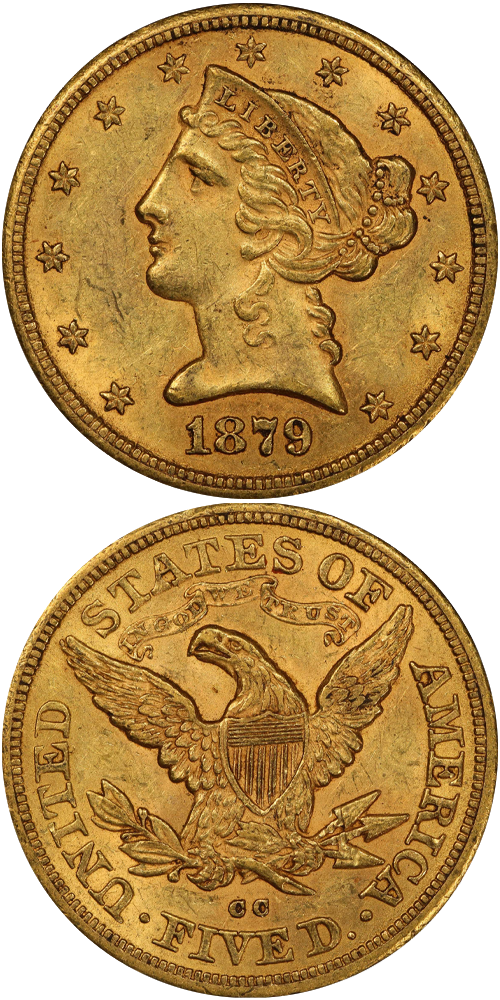1879-CC Liberty Head Half Eagle
Jeff Ambio: There are either two or three die marriages of the 1879-CC half eagle that employ two obverse and one or two reverse dies. The two different obverse dies are distinguishable by the absence or presence of a prominent die scratch through the lower serif of the letter E in LIBERTY. The reverse of the coin exhibits a small, even mintmark with the trailing edge of the arrow feather over the right side of the first C. This reverse die is either the same or very similar to that used to strike all known 1878-CC half eagles, and it appears to this writer (Jeff Ambio) that it is also the only known reverse of the 1879-CC.
Rusty Goe: Nevada state senators and assemblyman in session in the early months of 1879, stayed at the Ormsby House located across the street from the Capitol; and they drafted a resolution to memorialize Congress to stop Treasury Secretary John Sherman's order to abolish silver coin production at the Carson City Mint. Superintendent James Crawford submitted the letter he had received from Secretary Sherman to his friends in the state legislature. The letter was read to the entire body and excerpts of it were extracted and incorporated into the memorial they sent to Congress. If not rescinded, Sherman's order would force Crawford to cease the purchasing of silver for the making of dollar-sized coins, and would confine the mint's work to the coinage of gold, assaying, and the refining of bullion. These measures would cause a drastic reduction in his workforce. Virginia City's Territorial Enterprise on March 11, 1879, said Sherman's order would compel the region's miners, "with a Mint at [their] doors, where coining can be done as cheaply as in San Francisco," to incur extra expenses to ship their bullion to California, and to have half of it shipped back to Nevada in the form of coin.
By 1879, Nevada's miners were already sending about 100 times as much of their gold to the San Francisco Mint than they were depositing in Carson City, and about 13 times as much silver. Sherman's order, if carried out, would do even greater damage to the Carson Mint on the balance of bullion deposits. Barring a dramatic intervention, the situation at the Carson Mint in 1879 looked bleak.
Because of the diminishing bullion deposits, gold coin production in Carson City declined further, even more so than had happened in 1878. Coiner Levi Dague pressed out 3,784 half eagles before his department shut down in April 1879. After a four-month work suspension, he added another 14,125 half eagles some time between August and December. The 17,281-piece total for the year nearly doubled 1878's output, but came at the expense of a reduction in quantities of the other two gold denominations. Meantime, the San Francisco Mint was turning out a record number -- up to that time -- of half eagles.
The yield of half eagles at the Carson Mint in 1879 represented the third highest total for that denomination for that institution's first decade in business. Possibly one and a half to two percent of the original mintage of this date survives today.
Q. David Bowers: Rusty Goe estimates that 270 to 340 1879-CC half eagles exist today with four to six in Mint State. My estimate is two or three. In one of his studies published in 1994 Doug Winter said he knew of none in this grade. For circulated examples I estimate 130 to 200, most of which are VF, plus or minus. At the mint state level, as here, the 1879-CC is a great rarity.
The example to the left was sold by Stack's Bowers Galleries in the Fairmont Collection, Hendricks Set, where it realized $45,600.






